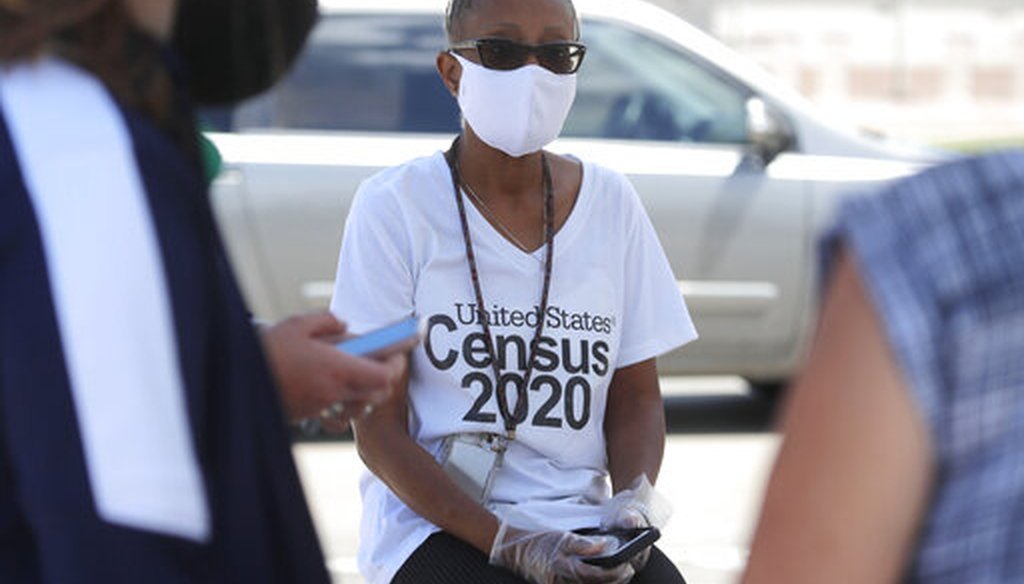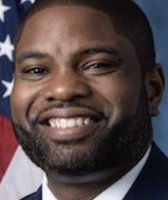Stand up for the facts!
Our only agenda is to publish the truth so you can be an informed participant in democracy.
We need your help.
I would like to contribute

Census worker Jennifer Pope wears a mask at a U.S. Census walk-up counting site in Greenville, Texas, on July 31, 2020. (AP)
If Your Time is short
• The pandemic is increasing the likelihood of an undercount in the 2020 Census.
• An undercount could affect congressional reapportionment and federal funding formulas, but experts say it could also undermine a wide range of federal statistics that are benchmarked and updated according to the basic population count.
As the once-every-decade Census approaches its completion, some observers are worrying about a rough landing.
It’s never an easy task to count hundreds of millions of Americans spread out through 3.7 million square miles. But the 2020 Census has faced a special set of challenges.
First came a fierce legal battle over the Trump administration’s effort to include a citizenship question on the most basic Census questionnaire. Opponents said the question would reduce the count of people who are noncitizens, especially those living in the United States illegally or their family members. After a court fight, the administration eventually backed down.
Then came the coronavirus pandemic, which posed severe challenges to a key element of the counting process — the traditional in-person counting process. Typically, Census "enumerators" reach individuals and families at their homes if they had not already sent in their forms or completed them online. Such efforts to contact hard-to-reach groups — which often include racial and ethnic minorities, low-income Americans, and people who live in rural areas — are deployed to avoid under-counting these groups.
Realizing the challenges of the pandemic, the Census Bureau pushed back the end of in-person enumeration from mid-August to Oct. 31. But then, in August, the Census Bureau announced that it wouldn’t be keeping enumerators in the field through Oct. 31 after all. Instead, the bureau said it would cease enumeration by Sept. 30.
This drew a chorus of opposition from groups who support a full count of Americans.
"There is no scientific rationale to cut short the work for this constitutionally mandated activity in this way," said the American Statistical Association in a July 31 statement. The American Association for Public Opinion Research agreed, saying that cutting enumeration short would be "a critical error that will damage the information infrastructure of the nation for at least a decade."
If a substantial undercount materializes — which is not a certainty — its most immediate impact would be on reapportionment. That’s the process of dividing the 435 U.S. House seats among the states, as well as the 50-state process of redrawing their own legislative districts. In the House, some states could gain or lose a seat, or several seats, depending on how the count ends up. The allocation of House districts also shapes the Electoral College for presidential races.
An undercount would also affect the formulas governing many types of federal funding, potentially taking away dollars that the undercounted states would be able to spend on services.
Beyond this, however, a significant undercount could affect a wide range of federal statistics that are shaped in part by the basic population count.
"If there are concerns about the quality of the Census data, it will ripple into virtually every other data product we use to understand who we are and how we are changing," Rebecca Tippett, founding director of Carolina Demography at the University of North Carolina’s Carolina Population Center, told PolitiFact.
Several demographers said in interviews that they are worried about the potential fallout from a Census undercount.
"While it’s not unusual for the Census to undercount people, a massive undercount would threaten to discredit the Census altogether," said Emily Klancher Merchant, an assistant professor of science and technology studies at the University of California-Davis.
The Census Bureau did not respond to inquiries for this article.
As of Aug. 25, the Census Bureau reported that 64.5% of American households had filled out their Census forms. Another 12.9% had been successfully recorded by an in-person enumerator, bringing the total to 77.4%.
So how does the Census Bureau collect data on the remaining 22.6%? Part of it will come from enumeration efforts through Sept. 30. But that isn’t the only arrow in the bureau’s quiver.
Enumerators have the fallback of asking neighbors or mail carriers to respond as proxy respondents if they can’t reach people personally. They can also access administrative records from the U.S. Postal Service, government agencies, and even data from commercial demographic services to determine whether housing is currently occupied, and to estimate the number of occupants and other basic characteristics.
Finally, the bureau can use statistical methods, known as "imputation," that leverage mathematical models to make an educated guess about a household and its characteristics.
"I suspect that they will still be able to count the ‘right’ number of people nationally," said Jennifer Lynne Van Hook, a Penn State University sociologist. "For households that do not respond, they will impute the people living in those households with information they gather from administrative data or neighbors, or as a last resort, they'll simply substitute the data from a nearby responding household."
But while information from neighbors, administrative records, and statistical models can fill out a lagging Census, experts said that in-person enumeration generally gives a better quality result. "The more data they impute, the more error there will be," Van Hook said.
Traditionally, Tippett said, the Census needs to impute about 1% of all households. But this year, she said, "I’ve seen some recent statements from former Census Bureau directors that, in a worst case scenario, the Bureau may need to impute 10-15% of households in certain areas. This makes us worried about new risks for an undercount."
Harder-to-count populations could suffer the most, said Anjana Susarla, a professor at Michigan State University's Eli Broad College of Business. "Counties with poor internet access, and neighborhoods that are home to racial or ethnic minorities and people with lower income or education levels, will be disproportionately affected if in-person counting were to stop," she said.
Problems with the basic population count could have follow-on effects in a wide variety of areas, because it is used to update many statistics regularly used by private business. Those include statistics on health, consumer spending, education, income, inequality, and poverty, experts said.
If that were to happen, he said, there would be a "loss of trust in the entire federal statistical system," said Douglas Massey, director of Princeton University’s Office of Population Research.
"One issue that immediately comes to mind is the benchmarking of the Current Population Survey, which is the basis for employment data, income and poverty data, and health insurance coverage, along with many other statistics," said Dean Baker, co-founder of the Center for Economic and Policy Research.
After every decennial Census, the Bureau of Labor Statistics updates its baseline estimates of the U.S. population, along with its gender, age, racial, ethnic, and geographical makeup. This information, in turn, is used to determine which neighborhoods or broader areas should be targeted when samples are drawn for the monthly Current Population Survey, said Brookings Institution economist Gary Burtless.
The updated Census information also provides sampling weights that allow the BLS to expand the Current Population Survey responses so they accurately reflect the experiences of various subgroups, Burtless said.
"Suppose the 2020 Census gives us incomplete information about young adults between 16 and 24, Hispanic Americans, or residents of big cities or large states?" Burtless said. "In that case, the BLS will ‘blow up’ the survey data incorrectly. The published monthly results could show an unemployment rate that is lower than the actual rate or will show an nationwide average wage rate that is higher than the actual rate."
All told, a poor count in the 2020 Census "could undermine the accuracy of labor market statistics over the next several years," Burtless said.
If the data is problematic, the Bureau of Labor Statistics might feel driven to fall back on alternate Census data collected separately from the decennial Census, Baker said.
Indications of an incomplete count could also send the Census Bureau or other agencies to court, experts said.
"We could see a lot of lawsuits surrounding the things that the Census is used for, which could stall a lot of government activity for a long time," Merchant said.
Our Sources
Census Bureau, "2020 Census Operational Plan, Version 4.0," December 2018
Census Bureau, response rate data, accessed Aug. 25, 2020
NPR, "Census Cuts All Counting Efforts Short By A Month," Aug. 3, 2020
Washington Post, "Abrupt change to census deadline could result in an undercount of Latino and Black communities," Aug. 9, 2020
New York Times, "New Census Worry: A Rushed Count Could Mean a Botched One," July 28, 2020
SCOTUSBlog, "Trump administration ends effort to include citizenship question on 2020 census," July 11, 2019
American Statistical Association, statement, July 31, 2020
American Association for Public Opinion Research, statement, Aug. 5, 2020
Email interview with Arloc Sherman, vice president of data analysis and research at the Center on Budget and Policy Priorities, Aug. 5, 2020
Email interview with Jay Zagorsky, senior lecturer at Boston University’s Questrom School of Business, Aug. 5, 2020
Email interview with Andrew Reamer, research professor at George Washington University’s Institute of Public Policy, Aug. 5, 2020
Email interview with Rebecca Tippett, founding director of Carolina Demography at the University of North Carolina’s Carolina Population Center, Aug. 5, 2020
Email interview with Emily Klancher Merchant, assistant professor of science and technology studies at the University of California-Davis, Aug. 6, 2020
Email interview with Jennifer Lynne Van Hook, Penn State University sociologist, Aug. 5, 2020
Email interview with Anjana Susarla, professor at Michigan State University's Eli Broad College of Business, Aug. 5, 2020
Email interview with Douglas Massey, director of Princeton University’s Office of Population Research, Aug. 5, 2020
Email interview with Dean Baker, co-founder of the Center for Economic and Policy Research, Aug. 5, 2020
Email interview with Gary Burtless, senior fellow at the Brookings Institution, Aug. 6, 2020


































